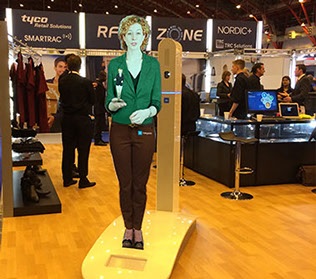Two examples of current technology that will help grow the digital signage industry are currently available and will continue to evolve with additional features and functions. First is the use of Bluetooth Low Energy (BLE) in beacons and the second is the advent of bi-directional audio employing avatars in digital signage, each technology fostered by IoT. The Internet of Things (IoT) is having a direct effect on digital signage. IoT in broadest terms is the connectivity of everyday devices via cloud based commands and providing feedback via the Internet. The devices, such as Smartphones and Smartwatches used by consumers will enable connectivity between that specific consumer and the digital signage device. This connectivity will allow messages to be targeted to that specific consumer’s interests.
Beacons
Combining social media feeds with specific consumer viewing. BLE enabled software provides a beacon function available for all iPhone and Android Smartphone models permits the user to control connectivity to company messages and order products. The beacon will identify who you are and databases will be searched to present relevant content to you consistent with the type of store you are visiting. It is initially delivered to consumers by embedding it into a firm’s application. Optional settings permit the creation of links, which can provide product information as well as order forms.
In contrast with Near Field Communication (NFC), which requires the consumer’s device to be very near an embedded coil or point of sale device, Beacons with Inaudible Audio Signal: Patented inaudible-sound mobile notification technologies and BLE standard (full support for iBeacon and Android BLE) to wirelessly interact with end-users through mobile apps – regardless of whether Bluetooth is turned ON or OFF – even in the absence of GPS, Wi-Fi, or 3G. This enables end-user targeting without draining phone batteries by way of sending inaudible modulated codes through existing infrastructure distribution points — i.e., standard audio speakers and playback systems, such as digital signage, video walls, kiosks, public address systems, TV and radio. BLE can reach fans both in-venue as well as watching the game or event at home!
On the API side, Google is launching two new APIs today for developers who want to use beacons for their apps. The Nearby API for Android and iOS now makes it easier for apps to find and communicate with devices and beacons that are nearby. That may be an art exhibit or a bus stop (Google has already worked with the transport authorities in Portland, OR to implement this).
Back-end Data and Analytics are also collected in real time. In example, when used in a sports venue, a solution that aggregates and integrates disparate data systems to create a complete view and comprehensive understanding of fan behavior and from which detailed analytics can be leveraged to not only evaluate historical fan behavior but to create strategies that influence fan behavior going forward. Seamlessly integrate, normalize, and cleanse data from separate ticketing systems, POS (Point of Sale) systems, CRM (Customer Relationship Management) systems, BI (Business Intelligence) tools, email marketing platforms, and social media sites.

Bob Killmeier, founder & president of Computer Controlled Designs LLC Avatar Bi-directional Audio
No longer confined to a rectangle box, digital signage video and bi-directional audio communicated by an avatar will become ubiquitous in venues such as airports, train station and bus stations delivering directional information in multiple languages. Greeters in bank lobbies will be supplemented with an avatar. Instructions on how to use ATM features and functions will be presented to consumers. Avatars are available in several styles, either as a fixed location with avatar in a static position, or as a pop-up “assistant” that is a great option for an exhibition, event or even a temporary location. This avatar is totally free to move around, attract people and give direction. Avatar technology with bi-directional audio can also turn any wall or surface into an intelligent ambassador.
In addition to presenting information, avatar systems also collect real time analytics including mood measurement, face detection and customer activities. These attributes can assist venue operators in determining traffic flow, customer questions and corresponding answers.

Image credit: VBC Bob Killmeier is the founder & president of Computer Controlled Designs, LLC, parlaying his 16 years (prior to retirement from Wells Fargo in May, 2013) as an Enterprise Project Manager and Web Application developer at Wachovia Bank (a Wells Fargo company). Previous to that he was also a former Chairman of PeopleSoft Financial Services Industry User Group (FSI-SIG), and for several years, served as head of IT at Piece Goods Shop a 400-store coast-to-coast retail chain.
Author Bob Killmeier is a member of the Digital Signage Expo Advisory Board and will be attending DSE 2016 March 15-18 at the Las Vegas Convention Center. For more information on any of the educational programs offered at DSE 2016 or to learn more about digital signage go to www.dse2016.com.
